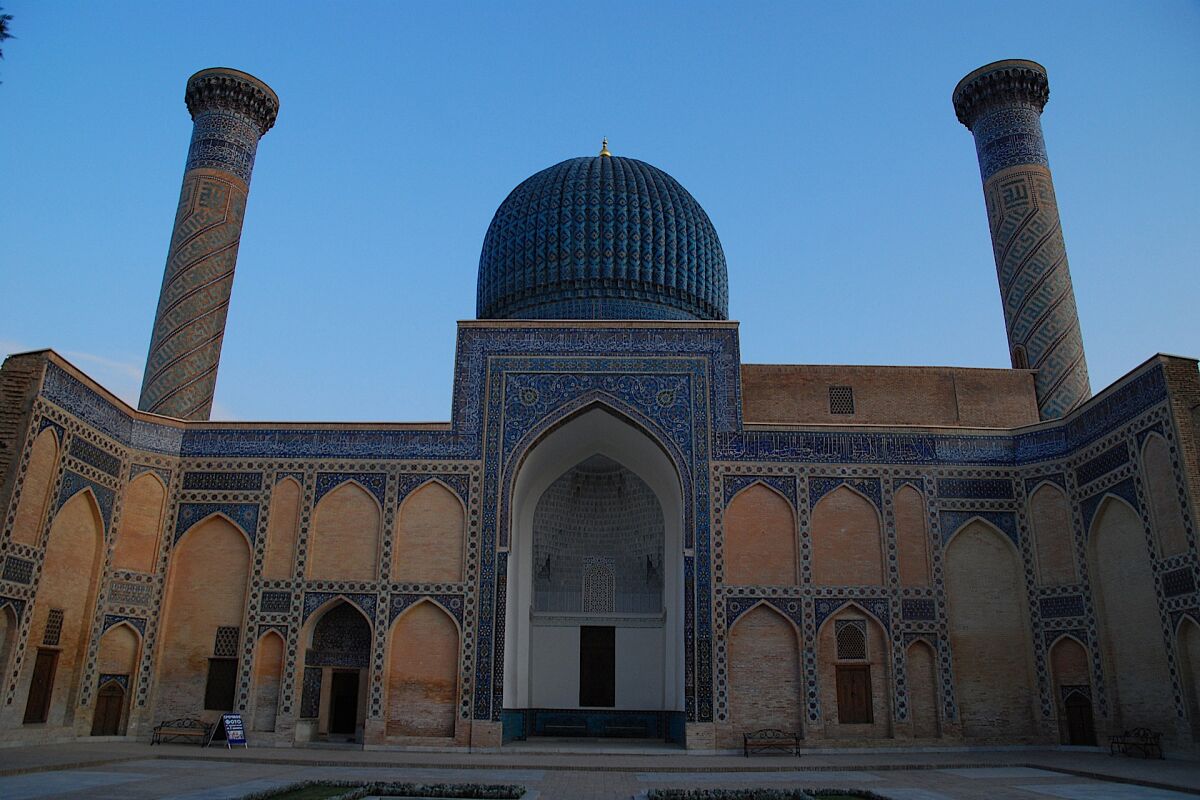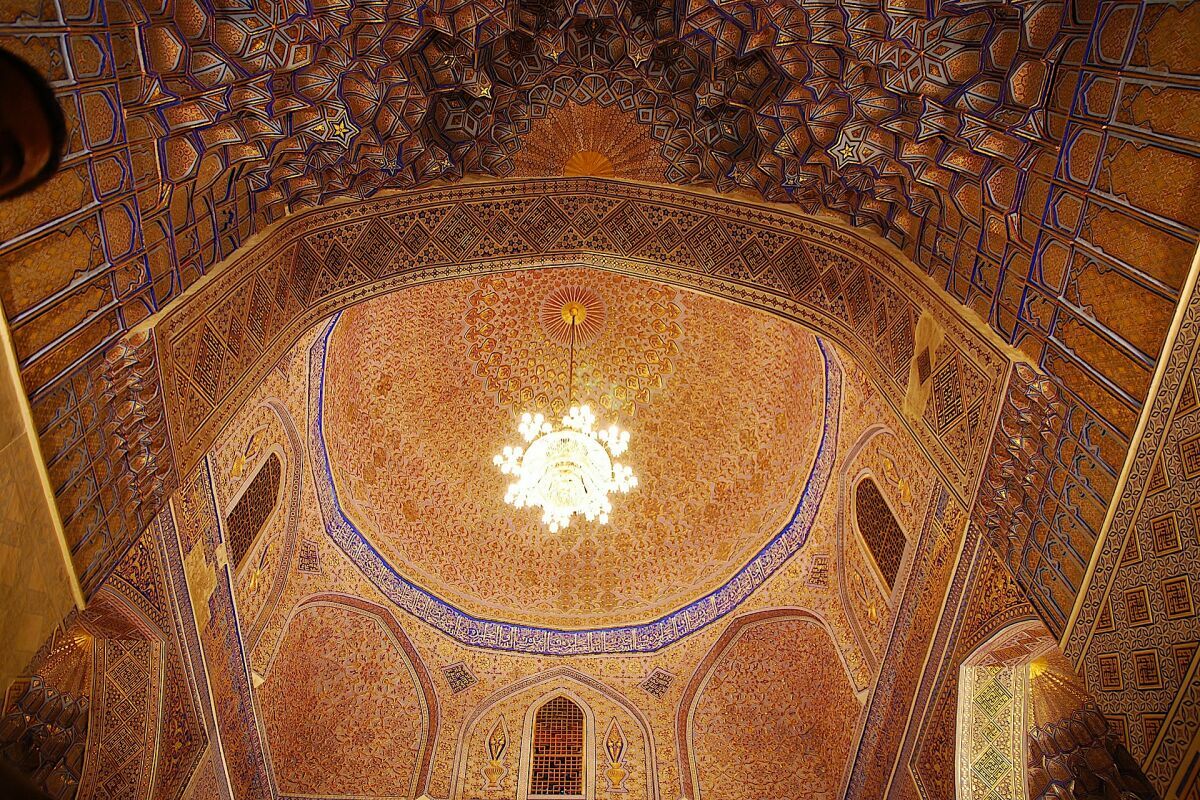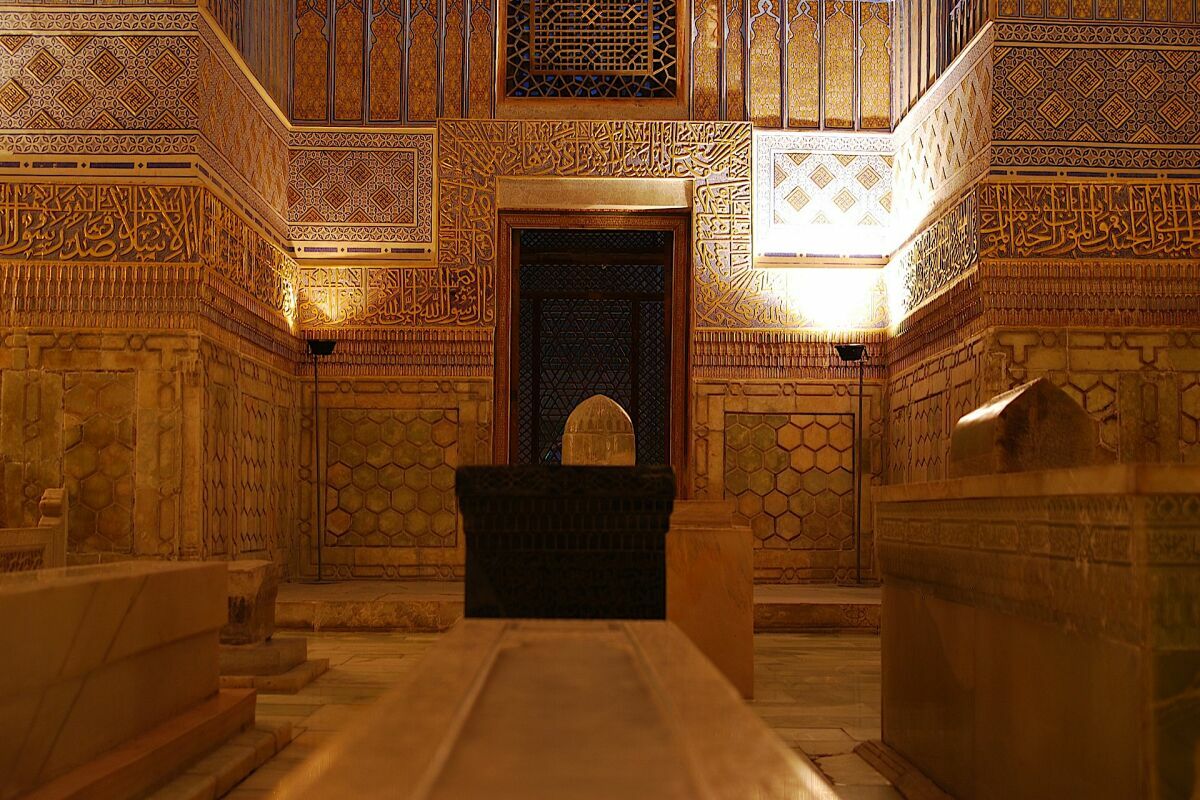Samarkand - Gur Emir Mausoleum
The inscription at the entrance to the Gur Emir mausoleum in Samarkand.
“The gracious and almighty Allah said: “Whoever enters here will find salvation!
“This is the paradise that was promised to us – enter it and stay in it forever!
Allah said: “Blessed and Allah Almighty, lead the righteous to Paradise and the rivers of Paradise, safe and secure. May the truth be above Almighty Allah!”
“The Prophet said peace be upon him: Death is the bridge that unites friends with friends.
“The Prophet said peace be upon him: Happy is he who lets go of the world before the world lets go of him; prepare his own grave before he enters it; please his Lord before he goes to him”.
Gur Emir means “tomb of the king” in Tajik. This architectural complex with its blue dome contains the tombs of Amir Temur (Tamerlan), his sons Shokhrukh and Miranshah, the grandsons Ulugbek and Sultan Muhammad.

Gur Emir is the mausoleum of the famous commander, ruler and founder of the Timurid dynasty – Amir Temur (Tamerlan) in Samarkand (Uzbekistan)
This mausoleum occupies an important place in the history of Islamic architecture, as it is a prototype of later mausoleums of the Grand Moguls (the Grand Mughal Empire in India), in particular the Humayun mausoleum in Delhi and the Taj Mahal in Agra, built by the descendants of Temur, who ruled in Northern India for several centuries.
Part of the complex was built in the late 14th century by order of Sultan Muhammad. Only the foundations of the madrasa and khanaka, the entrance door and part of one of the four minarets have been preserved to this day.
Construction of the mausoleum Gur Emir in Samarkand itself began in 1403 after the sudden death of Sultan Muhammad, the direct heir of Amir Temur (Tamerlan) and his beloved grandson. In fact only Amir Temur’s (Tamerlan) other grandson, Ulugbek, completed the mausoleum.
During his reign the mausoleum became the family tomb of the Timurid dynasty. The entrance of the ensemble of Sultan Muhammad is richly decorated with carved bricks and various mosaics. The door was artistically decorated by an experienced master (ustad) Muhammad bin Mahmud Isfahani.

Externally the mausoleum of Gur Emir is a single-domed building. It is known for its simple forms and monumental appearance. It is an octagonal building, which is crowned by a blue fluted dome.
The external decoration of the walls is made up of blue and blue and white tiles arranged in such a way that the geometric and epigraphic ornamentation on the background of terracotta tiles can be seen from afar.
The dome, 15 metres in diameter and 12.5 metres high, is painted with deep rosettes and white tiles in bright blue. The ribbed decorations give the dome an amazing expressiveness.
During the reign of Ulugbek, the passageway was created to provide an entrance to the mausoleum. Inside the mausoleum there is a high and spacious chamber with deep niches on the sides and a variety of decorations. The lower part of the walls is covered with onyx panels.
Each of these panels is decorated with paintings. Above the brick group there is a marble cornice in the shape of a stalactite. Large areas of the walls are decorated with various motifs; the arches and the inner dome are decorated with boxes made of papier-mâché, gilded and decorated with various motifs.
The decorative carved tombstones in the inner room of the mausoleum only indicate the location of the actual tombs in the crypt directly under the main hall.

Amir Temur also built a tomb for himself in Shakhrisabz, but when Amir Temur died in 1405 during his campaign to conquer China, the roads to Shakhrisabz were covered with snow and so he was buried in Samarkand.
During the reign of Ulugbek a dark green nephrite stone was laid over Amir Temur’s grave. This stone was formerly used in the temple of the palace of the Chinese emperor, then as the throne of Khan Kabek (descendant of Genghis Khan) in Karshi.
In 1740 the King of Persia – Nadir Shah – stole the stone, and it is believed that from that moment on it brought failure to his succeeding masters. His advisers convinced him to return the stone to its rightful place.
The second time the stone was stolen happened in 1941 when Soviet archaeologists discovered the burial chamber. During this research the sculptor Gerasimov restored the features of Amir Temur on the basis of his skull and it was also confirmed that he was a giant for his time, more than 1.80 m tall and paralysed.
The murder of Ulugbek and the authenticity of other graves were also confirmed. Next to Amir Temur’s grave are the marble gravestones of his sons, Shokhrukh and Miran Shoh and his grandsons, Sultan Muhammad and Ulugbek.
The remains of Mir Said Baraka, the spiritual teacher of Amir Temur, are also found in this mausoleum. Some architects see the Gur Emir Mausoleum, the Rukhabad Mausoleum and the Aksaray Mausoleum as a unified ensemble of mausoleums because of their proximity to each other.
